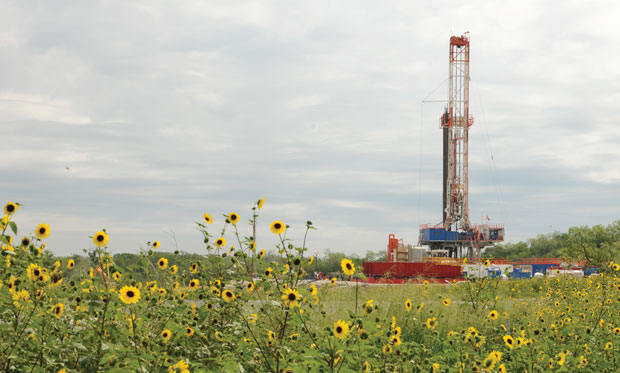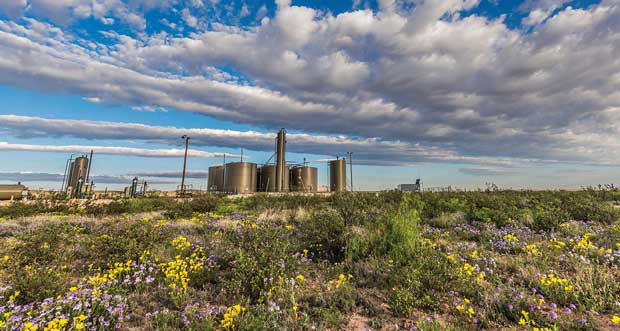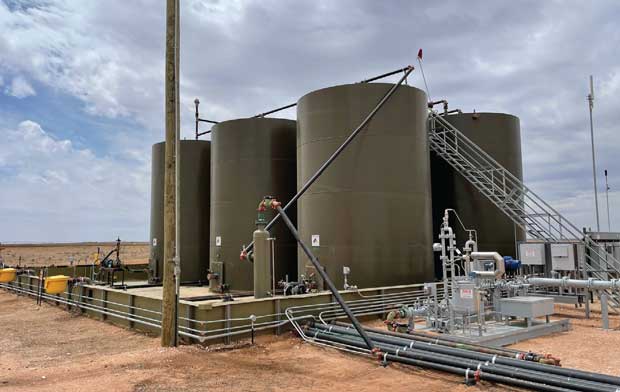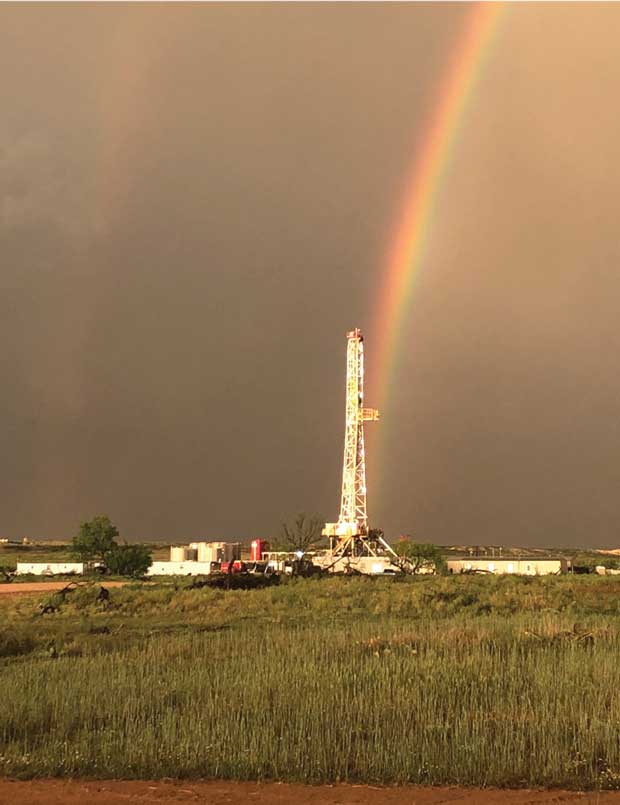
Permian Basin Activity
Permian Basin Plays Providing Plenty Of Targets For Operators Of All Sizes
By Danny Boyd, Special Correspondent
With West Texas Intermediate inching ever-steadily toward $70 a barrel and Henry Hub natural gas prices at $3.00 an MMBtu as the summer driving and cooling seasons begin, the Permian Basin is finding its mojo.
Operators have spent the past year strategically preparing for the future through mergers, bolt-on acquisitions, creative leasing, and partnerships in both the Midland and Delaware sub-basins while working to advance the latest hydraulic fracturing techniques and production solutions to fortify returns. While the basin’s players remain very much committed to capital discipline and managed growth, there is no denying the bullishness breaking out all across the playing field in West Texas and Southeast New Mexico.
In addition to taking advantage of top-tier positions and acquiring neighboring assets, operators are redefining the reach of “tier I” acreage in the eastern Midland Basin, proving the lucrativeness of the northern Delaware, and returning to legacy fields to apply techniques that are transforming economics in the legendary San Andres on the Northwest Shelf.
In the Midland Basin, Pioneer Natural Resources Company—a true Permian blueblood with an industry-leading acreage inventory—is busy folding 97,000 acres from its DoublePoint Energy acquisition into an established tier I position that Pioneer considers second-to-none.
The DoublePoint bolt-on, combined with the earlier acquisition of Parsley Energy, gives Pioneer 1 million Permian acres, including 900,000 in the eastern sub-basin, says Bonnie S. Black, vice president of drilling.
Pioneer now has 15,000 high-return, tier I locations, with DoublePoint adding 100,000 barrels of oil equivalent production, 61% of which is oil, according to Black. Pioneer projects 2021 oil production of 351,000-366,000 bbl/d and total production of 605,000-631,000 boe/d on a capital budget up to $3.25 billion. More than 6,700 gross productive wells were attributable to Pioneer at year-end.
Creating Synergies
DoublePoint’s Midland Basin position is equally competitive with Pioneer’s legacy inventory, Black states. The combination of Parsley, DoublePoint and legacy Pioneer creates synergies of more than $525 million and economies of scale that will allow the company to continue to drive costs down and strengthen its investment framework, she relates, with the addition of Double Point alone generating double-digit free cash flow for share accretion.
“It increases our variable dividend and certainly benefits our corporate return metrics in general,” Black says. “Double Point had a lot of tier I assets and when you combine its assets with our best-in-class operating efficiencies and cost structure, it makes us continue to be best-in-class in the Midland Basin.”
At the end of May, Pioneer was running 26 rigs and nine frac fleets and with efficiency gains expected to run from 22-24 rigs and seven to nine frac fleets over the year, says Black, who joined Pioneer in Alaska in 2007.
Pioneer Natural Resources’ acquisitions of first DoublePoint and then Parsley Energy are creating synergies and economies of scale across its extensive lease position that will allow the company to drive down costs, strengthen financial performance and deploy technologies such as simulfracs to improve bottom-line results.
The company expects to put 470-510 wells on production in 2021, and already had turned 106 new wells to sale in the first quarter, she reports. Pioneer will continue to average four wells per pad in the Midland Basin with average lateral lengths of more than 10,000 feet, principally tapping into the Wolfcamp A and B benches but with some Sprayberry completions, Black adds, and also is exploiting a joint venture position in Upton County.
According to Black, initial production rates of 1,500-2,000 boe/d are considered the “fair average” throughout Pioneer’s Midland footprint. In the Delaware Basin, where Pioneer holds 100,000 contiguous net acres, she says the company is targeting the Wolfcamp and Bone Springs.
While completion designs depend on targeted formations and development strategies, Pioneer averages roughly 50 barrels of fluid and 1,800-2,000 pounds of sand per lateral foot, with sand supplied largely from in-basin mines, Black explains.
The additions of Parley and Double Point, coupled with Pioneer’s longstanding commitment to advanced operating efficiencies, continue to allow the company to deploy the latest technologies–including simulfracs, in which two wellbores are stimulated simultaneously–to improve bottom-line results.
On a trial basis, Pioneer deployed the simulfrac technique on several sites so far this year, Black updates. “We have done trials that have come with encouraging results and we expect to do more trials in the second quarter,” she says. “By using this technique, we expect to reduce the overall time to frac all of the wells on a pad, and with that reduce the overall cost to complete the wells, but we are not changing the actual completion design and expect there to be no performance degradation.”
Perfecting Completion Design
In the Delaware Basin, recent completion results demonstrate the fruits of a multiyear program underway at Devon Energy to deliver highly predictable, competitive measurables from a geologically diverse basin that includes up to a dozen potential targets with multiple landing zones, says John Raines, vice president of Delaware north assets.
“A lot of times when the industry talks about resource plays, people generally assume that the resource is consistently pervasive, but the Delaware is not the Barnett Shale or the Cana Woodford,” he offers. “It is relatively very diverse from a geologic standpoint. Just because you derisk the Upper Wolfcamp in one acreage block does not mean you have done that in a block nearby.”
As a part of prolific Upper Wolfcamp development in Lea County, N.M., Devon posted average 30-day IPs of 5,100 boe/d on four Wolfcamp wells in its Danger Noodle program within the company’s Thistle Block, Raines points out. Included are two wells in the Wolfcamp XY and two in the Wolfcamp A. Devon also plans to develop the Avalon there.
Devon Energy is focused on optimizing completion designs in the Delaware Basin using different approaches utilized by Devon in the northern Delaware and WPX Energy in the southern part of the basin prior to the two companies’ merger. The early results are encouraging, with 30-day IPs up to 4,200 boe/d for Wolfcamp wells with 7,100-foot laterals in Eddy County, N.M.
Work is conducted on two pads with walking rigs under contract able to return to a pad and drill beside producing wells, details Rich Downey, vice president of drilling and completions.
The company continues to perfect its completion designs as it examines different approaches utilized by Devon in the northern Delaware and WPX Energy in the south prior to their “merger of equals” earlier this year, says Downey, who joined the combined company from WPX. One such enhancement benefitting the Stateline area, a WPX legacy project, multiple 1.5-mile laterals are being developed with three-mile laterals, optimizing efficiencies and cost of the development. As Devon has been drilling and completing three-mile laterals the northern basin best practices can be applied immediately to the project, he adds.
“The merger is giving us the opportunity to move engineering staffs to focus on the best techniques,” Downey comments. “We are having phenomenal results as we continue to look at how we can do it better.”
Nearby, Right Meow, a high-return, eight-well Bone Spring development near the boundary between Eddy and Lea counties, included average per-well 30-day IPs of 2,400 boe/d from lateral lengths of 10,500 feet. Located in Devon’s Todd Block, the wells were drilled from three pads, Raines says. The company already is in the process of executing a subsequent Wolfcamp development program at Right Meow, leveraging existing pads with layout complexity dictated partially by ownership issues, he points out.
At the south end of Devon’s Cotton Draw block, 30-day IPs from its Thoroughbred project in Eddy County on two of 11 Wolfcamp wells included average 30-day IPs of 4,200 boe/d from 7,100-foot laterals.
At Thoroughbred, the company is spacing well delivery out through the quarter as it continues to do reservoir testing and diagnostics and develop and test spacing on the Third Bone Spring sand through the upper Wolfcamp, Raines says. The shorter laterals on the far west portion of acreage are about 1.5 miles long while the remaining wells will be two miles long, adds Raines, a Devon Energy veteran of 15 years.
Altogether in 2021, Devon plans to spend approximately 80% of its roughly $1.7 billion budget in the basin and keep an average of 13 rigs and three frac crews busy, Raines says. Between 215 and 225 spuds are planned and between 225 and 250 new well deliveries.
The federal permit inventory continues to grow, with Devon adding more than 50 permits since the lapse in March of a 60-day order freezing U.S. Bureau of Land Management permit approvals. The company’s permit inventory now stands at more than 500, with the permits being an integral part of being able to plan infrastructure build-out to accommodate Delaware production growth over the next few years, Raines says.
Record Lateral Length
Henry Resources LLC marked a milestone this year with its first 2.5-mile lateral as part of an overall program that emphasizes aggressive completion strategies supported by extensive data sharing, says company President David Bledsoe.
“We feel like we are on the cutting edge of frac designs, including the numbers of stages, the number of clusters per stage, cluster spacing and sand and fluid loading,” he says.
The record lateral for the company, which was running two rigs in May, comes in Upton County in the southern Midland Basin, where Henry Resources is focusing on developing its Wolfcamp rights, Bledsoe says.
Henry Resources LLC has completed its first 2.5-mile lateral in the southern Midland Basin as part of a program that emphasizes aggressive completion strategies supported by extensive data sharing to optimize production over time and avoid pulling down pressure and crushing proppant and bringing gas out of solution.
In the area, 30-day IPs have ranged from 1,000 to 1,500 bbl/d with the highest in the 1,400-1,500 bbl/d range, he says. With sand loading from 1,000 to 2,000 pounds per lateral foot, the company is pumping 100-mesh sand from in-basin mines as it focuses on optimizing production over time to avoid over aggressively pulling down pressure, crushing proppant and bringing gas out of solution quicker, Bledsoe explains.
Overall, the company’s net, operated production includes about 18,000 barrels of oil and 30 MMcf of gas a day, he says, with Henry Resources operating about 200 wells and 90% of its net production.
Partners include Chevron, Pickering Energy Partners, and Grey Rock Energy Partners. Although 80% of its position is in the Midland Basin, Henry Resources continues to develop Delaware acreage in Reeves County, Tx., where it has drilled eight wells over the past two years targeting the Wolfcamp A and C, Bledsoe says.
“Those are great wells, and make more oil than the Midland Basin wells, but they also make more water and you have to be careful about how you frac them because you can bring in a lot of hydrogen sulfide, which is very costly to treat,” he explains. “We are extremely careful and very deliberate about how we complete those wells. They make more oil but cost more money, so the economics in general are a little better in the Midland Basin.”
With roots in a firm co-founded by Permian Basin legend Jim Henry more than 50 years ago, Henry Resources relies on a formidable land program with expertise in putting together creative deals in a basin with little unleased acreage, he says. The focus is on bringing to the table parties with partial interests or rights, he says.
The Henry name opens doors with rights holders and other producers, a testament to Jim Henry’s legacy, Bledsoe adds. “Our calling card is being a company of integrity that operates on Christian values and that values being a good partner that in turn values win-win deals,” he says. “That is how you keep deal flow going, by being a good partner and being an attractive company.”
Second To None
While the Delaware and Midland basins are the primary Permian attention getters, the Northwest Shelf is offering opportunities for Steward Energy II LLC, which is using unconventional technologies to develop oil reserves beneath and beyond the historical boundaries of legendary conventional Permian fields, says Founder and CEO Lance Taylor.
Based in Frisco, Tx., the company is drilling horizontal San Andres wells on its acreage surrounding the historic Wasson and Brahaney fields, he says. Steward II plans to drill 16 wells this year with the goal of moderate production growth while maximizing distributable cash flow, adds Taylor, a fifth-generation oilman who launched the company in July 2015. So far, he says, Steward II has drilled and completed eight wells through midyear.
“The shallower conventional rock leads to more affordable drilling and completion operations while delivering a lower decline production profile,” Taylor points out. “When done well, the economics are second to none.”
Steward Energy II is deploying unconventional technologies to develop new reserves in the San Andres play, where the company plans to drill 16 horizontal wells this year. It operates 150 horizontal San Andres wells, representing about half of its proved inventory.
A petroleum engineer by training, Taylor held positions with Anadarko Petroleum, Pioneer Natural Resources, Denbury Resources and Eagle Oil & Gas before founding Steward Energy LLC in August 2012 in a partnership with Natural Gas Partners. Steward I built and commercially tested a 10,000-acre position in the southern Delaware Basin and sold it in late 2014.
With NGP’s continued sponsorship, Steward II is taking advantage of the San Andres formation’s natural permeability, combined with hydraulically fractured horizontal wells to maximize near-wellbore conductivity, Taylor says. The company pumps less than 1,000 pounds of proppant carried in less than 20 barrels of slurry per lateral foot pumped at a rate of more than 70 bbl/minute, he reports. According to Taylor, proppant is typically 30-50 mesh and the fluid system requires high-quality cross-linked gel. Gas-to-oil ratios initially average 1,000-to-1, with typical 30-day initial oil production rates of 500-600 bbl/d.
All of the company’s produced water is piped to its own disposal wells, he says. Steward II also has an active workover program that involves mechanically cleaning out and chemically treating calcium sulfate scale with a hydrochloric acid treatment, yielding additional reserves for a relatively small investment, Taylor says.
Currently, the company’s production is 13,000 net boe/d with proved reserves greater than 100 million boe, Taylor details. Currently, the company operates 150 horizontal San Andres wells, which represents about half of its proved inventory, and continues to keep an active interest in accretive acquisitions.
Building A Position
At the beginning of June, Midland-based Custer & Wright Operating was set to spud a horizontal San Andres well for completion by mid-summer as part of its program to methodically build a position westward from its Northwest Shelf acreage in Yoakum and Gaines counties, Tx., says company engineer Dustin Petraitis.
“There are good wells up there,” he remarks. “For all the prospecting and moving around in the Permian Basin, I have found few places that work better than the San Andres.”
Still, location selection is paramount on acreage offset to the Slaughter Field, with some locations providing lucrative possibilities and others being suspect, Petraitis cautions.
Company President Paul Wright and his founding partner, the late Art Custer, worked in various areas of the basin over the years, including as nonoperating working interest owners. The company moved up to the Shelf six years ago and now operates about 20 wells and holds rights to 1,200-1,300 acres, Petraitis says.
Some area San Andres fields saw their heyday in the 1950s, and over time, operators ventured elsewhere, but the advent of horizontal drilling and advancements in frac designs has generated a new set of possibilities, he says.
With vertical depths of about 5,300 feet, the San Andres is being exploited with one-mile and 1.5-mile laterals, with stimulations looking in some cases more like conventional fracs from a decade ago, Petraitis offers.
Treatments include 30-50 mesh sand, and thicker fluid with a cross-linked gel, he says. Wells can be completed with 4 million pounds of sand and total fluid volumes of 95,000 barrels.
Early, 30-day IPs typically range from 500 to 600 barrels of oil daily, although some have exceeded 700 bbl/d, he says. GORs range from 1,000-to-1 to 1,400-to-1, Petraitis says.
Two-Pronged Strategy
Denver-based Bayswater Exploration & Production is turning a two-pronged Permian Basin strategy into success through its ownership of mineral/royalty interests in the Delaware Basin and an operated working interest position in eastern Midland Basin acreage that is proving to be more than a “second-tier” property, says John Dyer, Permian Basin asset manager.
Privately funded, Bayswater has been a principal in a series of energy funds since 2010 that provide direct investment opportunities in oil and gas assets for its limited partners, which include college endowments and pension funds, Dyer says.
The company has built a 10,000-net royalty-acre position in both the Texas and New Mexico portions of the Delaware, which includes royalty interests in 1,100 gross producing wells, providing its limited partners exposure to the rewards of the sub-basin without the risks of direct well costs, he says.
Bayswater Exploration & Production holds royalty interests in 10,000 nets acres in the Delaware Basin and an operated position in the eastern Midland Basin, where it has 26,000 contiguous net acres. Some of the company’s wells contact the Wolfcamp at only 5,700 feet, making it one of the shallowest, lowest-cost development areas in the Midland Basin.
Conversely, in the Midland Basin, Bayswater has built a 26,000 contiguous net acre position in Howard County, 95% of which it operates, Dyer explains.
“Some of our horizontal wells are penetrating the Wolfcamp formation at 5,700 feet, making this one of the shallowest, lowest-cost areas to be developed in the basin,” he adds. “Oil gravities are in the mid-30s, and the low initial and overall life-of-well GORs yield a very oil rich with high revenue per producing lateral foot investment.”
Bayswater initiated its grass-roots leasing program in Howard County in 2016 and complemented its leasing effort with bolt-on producing property acquisitions. The company began drilling in 2018 and has since completed 20 horizontal wells, resulting in most acreage being held by production.
Although the company’s initial strategy was to acquire “tier II” properties, Bayswater’s geologic assessment of existing vertical wells indicated that “tier I” conditions existed in terms of organic content, thermal maturity and overall pay thickness, Dyer notes.
This year, the company will bring 27 new wells into production, more than doubling its well count, he reports. In late May, drilling was ongoing on the eight-well Fort Knox pad, and Bayswater plans to maintain a one- to two-rig program as long as prices and service costs remain favorable and the company can continue to meet internal rate-of-return targets, Dyer says.
Tested horizons include the Wolfcamp A, B and D and lower Sprayberry, with the Wolfcamp A and B yielding the best results, he says. Upper Wolfcamp wells usually take 20 days to cut oil and achieve peak rates of 750-1,000 bbl/d in 40-60 days before plateauing and declining, Dyer details.
Because wells in the area are only slightly above normal pressure and get very little unassisted post-frac flow, Bayswater converts them to electric submersible pumps almost immediately, Dyer reports.
Although completion designs vary on a zone-by-zone basis due to differences in lithology, the basic frac design includes stage intervals of 165 feet with 2,200 pounds per foot of proppant and 50 barrels of fluid pumped at a rate of 100 bbl/minute. The slickwater fracs include 30% 100-mesh sand, with the remainder 40/70-mesh with a diverter pumped on all stages, he says.
Wells with 10,000-foot laterals are being drilled averaging 10 days from spud to rig release, he adds, with DC&E costs around $500 per lateral foot.
Bayswater has in inventory of approximately 44 half-mile wide by two-mile long DSUs resulting in an inventory of between 170 and 200 high-value undrilled locations, Dyer says. Infrastructure is being designed to service the 200 future locations regarding oil, gas and water takeaway, he adds.
For other great articles about exploration, drilling, completions and production, subscribe to The American Oil & Gas Reporter and bookmark www.aogr.com.











